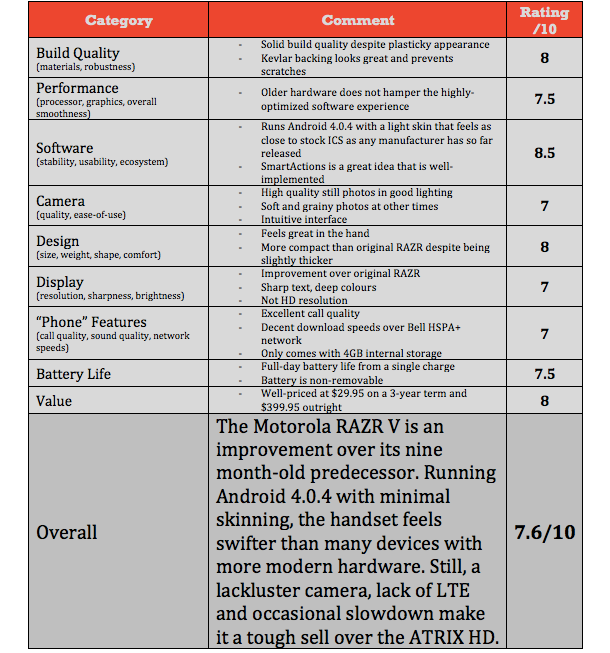
What was once considered a fantastic device must be weighed against others recently released, and usually in the same price range. The Motorola RAZR V is in a very interesting position right now for those two reasons.
Motorola hasn’t made too much noise since the release of the revamped Rogers-exclusive RAZR in November. Now, nine months later, the RAZR V hits the market on Bell and Virgin for a significantly more affordable price in a body that makes some concessions to achieve it. In many ways this is the same phone that Motorola released last year — internally and externally — but stands on its own with a great new build of Ice Cream Sandwich and a more compact design. Is it worth your time and money? Read on to find out.
Specs
– Android 4.0.4 with (slightly) custom Motorola skin
– 4.3-inch 960×540 TFT display with ColorBoost
– 1.2Ghz dual-core TI OMAP 4430 SoC
– 1GB RAM, 4GB internal storage, microSD slot
– 8MP back camera with flash, 0.3MP front-facing camera
– WiFi, GPS, Bluetooth, FM Radio
– 65.8 x 128.5 x 8.35 mm
– 125g
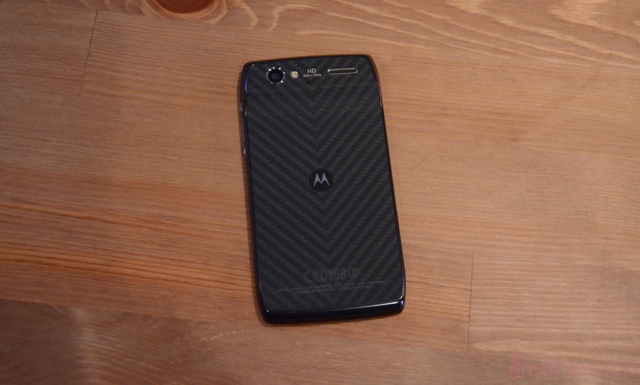
Design & Display
The RAZR V definitely resembles the original with its angular face, sloping Kevlar backing and chrome accents, but Motorola has certainly toned down the quality of materials. While the RAZR V by no means feels cheap, there is a definite plasticky aspect to it that was absent on the premium-feeling RAZR.
The RAZR V is also some 5mm narrower than the sometimes-unwieldy RAZR, and it feels much more comfortable in the hand as a result. The screen, too, while on paper the same as the RAZR — a 4.3-inch display at 960×540 pixels — is somewhat sharper and less distracting than its predecessor. Instead of going the Super AMOLED route, Motorola opted for a traditional TFT LCD display, making text significantly sharper and whites much more accurate. While it loses the deep blacks and lovely colour saturation that comes with a Super AMOLED screen, we did not miss the RAZR’s moiré aberrations and distinct lack of sharpness.
While the device, at around 8.4mm thick, does not come close to the impossibly thin dimensions of its predecessor, we think Motorola made the right move for the end user. It’s more compact overall, which makes it feel like a smaller handset despite being 1.3mm thicker than the RAZR.
Note that the RAZR V uses a regular-sized SIM over a microSIM, and shares a latch door with the microSD slot on the left hand side. The volume rocker is nicely delineated on the right, and the power button, headset jack and microUSB port sit flush on the top.
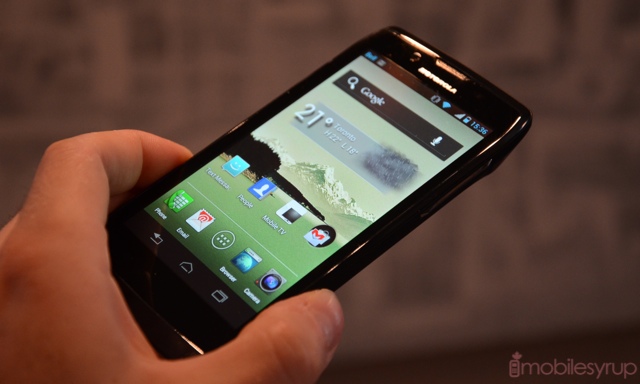
Performance & Software
As the RAZR V uses largely the same internal hardware as the Rogers version released last year, we weren’t expecting any performance miracles. Motorola has done a lot with the software, however, and this is not your mother’s MOTOBLUR. The version we see on the RAZR V, which runs Android 4.0.4, resembles in many ways the stock Ice Cream Sandwich experience. While transitions between homescreens are not quite as smooth as those on the Galaxy Nexus, we felt right at home navigating around the menus.
The RAZR V uses Texas Instrument’s aging OMAP 4430 processor clocked at 1.2Ghz, with 1GB RAM and 4GB internal storage. It’s also limited to Bell’s HSPA+ network at 14.4Mbps, but many of these things are built into the price. Still, considering the ATRIX HD LTE is only $20 more on the same Bell network and offers a better array of internal hardware and software, we’d be inclined to recommend that one over the RAZR V. If you’re insistant on the smaller form factor, you’ll be pleasantly surprised by the spritely app load times, total lack of lagginess when scrolling through the browser, and a stability that could only have come from Motorola.

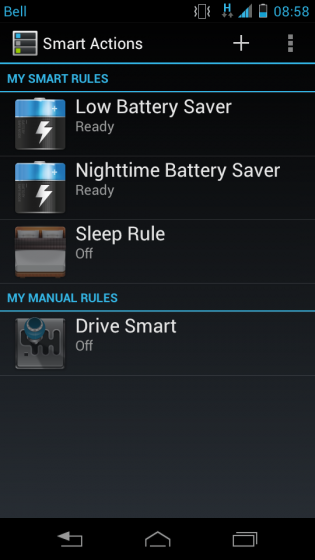
The company’s SmartActions have been updated for ICS, and now provide recommendations based on usage patterns. For example, the device can keep track of your favourite locations or times of day and, based on your battery life, enable a Battery Saving mode. Similarly, if you tend to go to bed every night around midnight, you can have SmartActions enable Silent Mode and suppress the screen from turning on during the night if you receive a notification.
Motorola has also added a four-way lockscreen shortcut system that provides easy access to the camera, phone and messaging. But perhaps the most notable admission of Motorola’s integration into Google’s corporate culture is the inclusion of virtual buttons in place of capacitive ones. Both the RAZR V and ATRIX HD LTE sport the Galaxy Nexus-like on-screen navigation icons, and while they have been slightly altered from stock, they work identically. We couldn’t be happier.
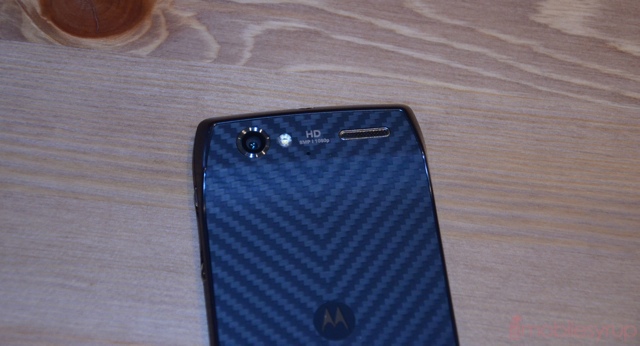
Camera
The 8MP camera on the RAZR V does a decent job at capturing moments in good lighting, but suffers from Motorola’s reliable distortion and softness. That’s not to say the camera is bad — the interface is fantastic, with easy-to-reach granular controls, and the shutter is snappy for a piece of older tech — but it doesn’t reach the heights of other 8MP sensors on the market. With the bar being set so high by the iPhone 4S, Galaxy S III and HTC One X, it’s easy to dismiss the RAZR V as underperforming. But we have to take into account the handset’s price — $399 outright or $29.95 on a 3-year term — and cut it a bit of slack as a result.
The device can also shoot modestly smooth and detailed 1080p video, though again it lacks the sharpness and smoothness of its ATRIX HD LTE sibling. The VGA front-facing camera does a decent job at video chats and vanity shots, but we wouldn’t recommend using it for anything other than a mirror.
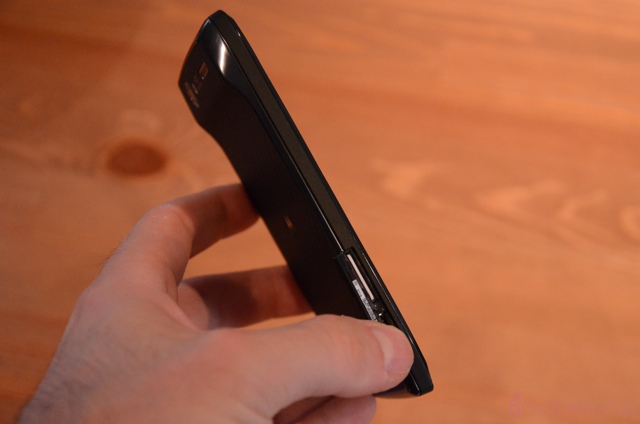
Battery Life
SmartActions is supposed to allow your battery to last up to 30% longer than an equivalent device, but we were happy to find that the RAZR V didn’t need it to last a full day. The 1750mAh battery was sufficiently large to see us through most of the day with regular calling, browsing, emailing, photo-ing and more. While the PowerVR SGX540 GPU is no longer the graphical beast it once was, we found it to be pretty light on the battery wallet when playing games or watching video.
We were a bit vexed that Motorola didn’t manage to squeeze in a larger battery — something like the 3300mAh cell of the RAZR MAXX would have been nice — considering all the extra proverbial legroom, but we’d imagine it would have raised the price of the handset considerably. Nevertheless, the juice, coupled with liberal application of battery-oriented SmartActions, should allow for one-day-plus usage from the RAZR V.
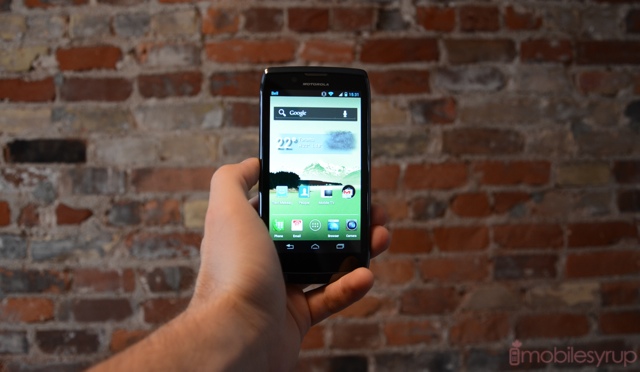
Call Quality, Network Speed & Miscellaneous
As with all Motorola phones, the RAZR V is solid as a phone. Call quality is unsurpassed in the industry, with a sharp, clear feed that never sounds muddled or sibilant. Call volume, too, is more than adequate for even the loudest of rooms, and Motorola’s background noise suppression works very well.
Because the RAZR V is a HSPA+ device, it’s network speeds are limited to Bell’s 3G network. We were able to achieve around 4-6Mbps download and 0.5-2Mbps upload depending on the location and time of day. Compared to the newest LTE devices this is nothing to write home about, but we were pretty pleased with the performance overall.
Bell and Motorola have bundled a number of apps on the RAZR V, including some business-oriented services such as Citrix GoToMeeting and Receiver. There’s also a full version of Gameloft’s Asphalt 6 and Bell’s Mobile TV app, among others. Because the platform has been upgraded to Ice Cream Sandwich, you can now disable unwanted apps, which is the next best thing to being able to uninstall them.
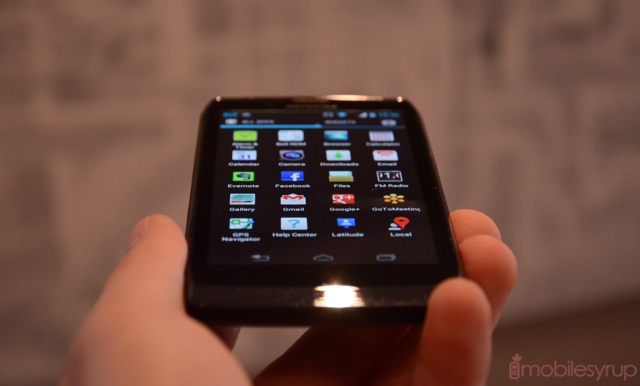
Conclusions
The Bell Motorola RAZR V is a good little smartphone at a decent price. Because its bigger brother, the ATRIX HD LTE, is priced so closely — just $20 more than the RAZR’s $29.95 on a 3-year term — we can’t fully endorse it unless you’re buying it outright. At $399.95, it’s an excellent deal if you’re looking to go off-contract and want an all-round high-performing handset with a great screen, good battery life and a solid, close-to-stock operating system.
